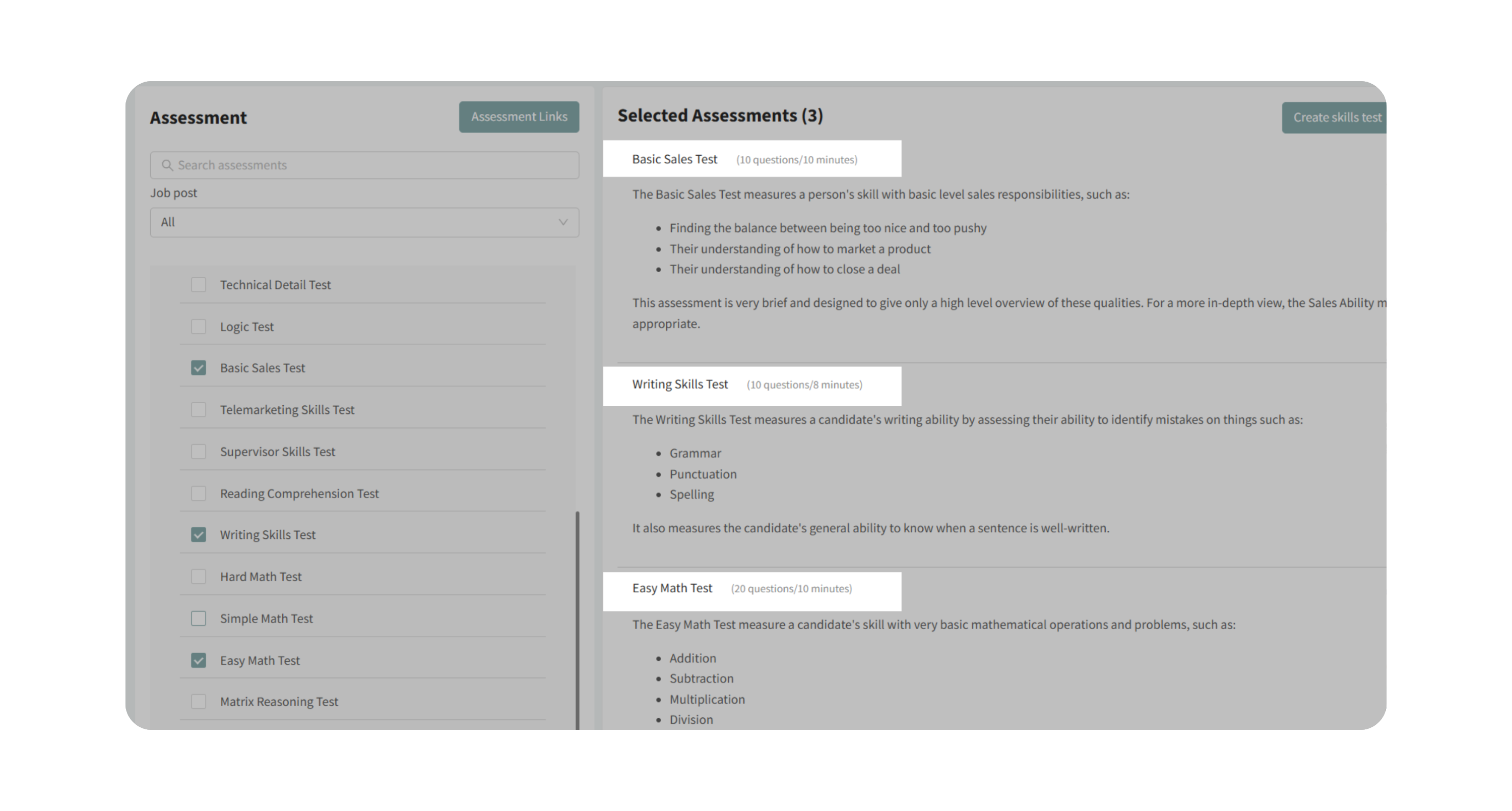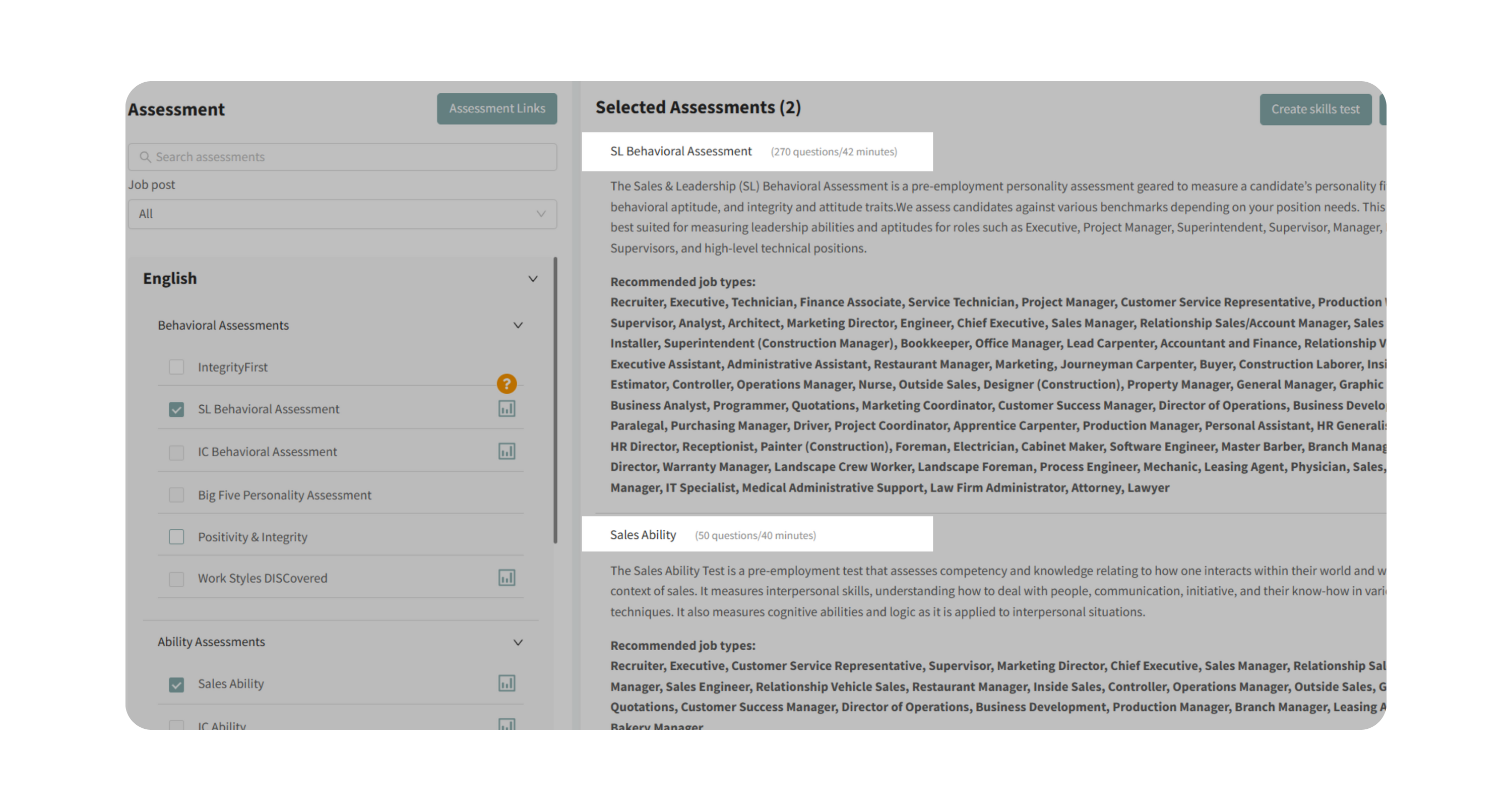When and Where to Use Assessments in Hiring
Overview
Hiring is both an art and a science. Assessments bring science into the process by providing objective data on whether candidates are likely to succeed in the role. But timing matters. If you place assessments too early, you risk losing great candidates before they’ve engaged with your opportunity. Place them too late, and you waste time interviewing people who aren’t a fit. The key is balance—aligning assessment timing with candidate volume, role complexity, and the investment required from candidates.
Key Considerations
1. Assessment Length & Candidate Drop-Off
- Short assessments (e.g., Integrity checks, basic skill tests like Attention to Detail) can be used early—even at application—because they require minimal effort.

- Longer assessments (e.g., Behavioral + Ability combos that take 60+ minutes) work best once candidates have shown interest. Using them too early increases risk of drop-off, especially in competitive markets.

2. Volume of Applicants
- High-volume roles (admin, entry-level, customer service): Early assessments are essential. You can even use full Behavioral + Ability combos at application to quickly filter large pools.
- Low-volume or specialized roles (executives, niche technical experts): Place assessments later (after resume screen or phone interview) to avoid scaring off scarce talent.
3. Quality of Applicants
- Unqualified applicants common: Use early assessments to filter quickly and reduce recruiter time.
- Pre-vetted or referral-heavy pipelines: Delay assessments until after an initial conversation to avoid creating friction.
Best Practices by Hiring Stage
At the Point of Application
- White-collar/admin/professional roles: Use a Behavioral + Ability combo (60 min). Filters out weak candidates early when applicant flow is high.
- Blue-collar/frontline roles: Use short IntegrityFirst or skill-based tests (10–15 min). Screens for honesty, reliability, or baseline skills without discouraging applicants.
After Resume Review / Initial Screening
- Introduce Behavioral (SL or IC) + Ability (IC or Sales Ability).
- Use when the candidate pool is moderate in size.
- Helps confirm personality, problem-solving, and people skills before interviews.
After Initial Phone Screen
- Best for scarce or specialized talent.
- Introduce a full battery of assessments: Behavioral + Ability + role-specific skill test.
- Shows respect for candidate time while still delivering robust predictive data.
Later Stages (Pre-Final Interview/Offer)
- Use job simulations or working interviews to validate earlier results.
- Confirm integrity and attitude via structured reference checks.
- Use this stage for confirmation and validation, not broad filtering.
Practical Framework
Hiring Scenario | Recommended Approach |
| High Volume + Low Scarcity | Use longer Behavioral + Ability combo at application (white-collar). Use short IntegrityFirst/skill test at application (blue-collar). |
| Moderate Volume + Mid-Level Roles | Add Behavioral + Ability after resume review or initial screen. |
| Low Volume + High Scarcity | Delay robust assessments until after the phone screen. |
Choosing the Right Assessment for the Role
1. Behavioral Assessments
- SL Behavioral (Sales & Leadership): For sales, leadership, or management roles.
- IC Behavioral (Individual Contributor): For non-leadership, non-sales roles.
- Reveals personality fit, integrity, and cultural alignment.
2. Ability Assessments
- IC Ability (People & Logic Aptitude): Measures emotional intelligence, people-handling, and reasoning. Useful across most roles.
- Sales Ability: Includes IC Ability + sales-specific techniques (closing, relationship selling, solution selling). For sales and sales leadership roles.
3. Skill Assessments
- Attention to Detail Test: Best for accounting, administration, logistics, or roles with sustained detail work.
- Other role-specific skills: Math, writing, technical skills as needed.
- Use only when the role truly requires it.
Tip: Always select the job type that best matches responsibilities (not just the title). This ensures benchmarking against the right high-performer group.
Why This Matters
- Ensures assessments are placed strategically to balance candidate experience and predictive value.
- Saves recruiter time by filtering effectively at the right stage.
- Reduces the risk of losing top talent in scarce markets.
- Aligns assessments with real job demands, making results more meaningful.
Final Takeaways
- Match assessment length and type to role and candidate volume.
- Use longer combos early when you have high applicant flow.
- Use short screeners early in frontline roles.
- Delay robust assessments when candidate supply is scarce.
- Always confirm integrity and culture fit before making final offers.
When used thoughtfully, assessments streamline your hiring funnel, reduce bad hires, and help you consistently identify top performers.
